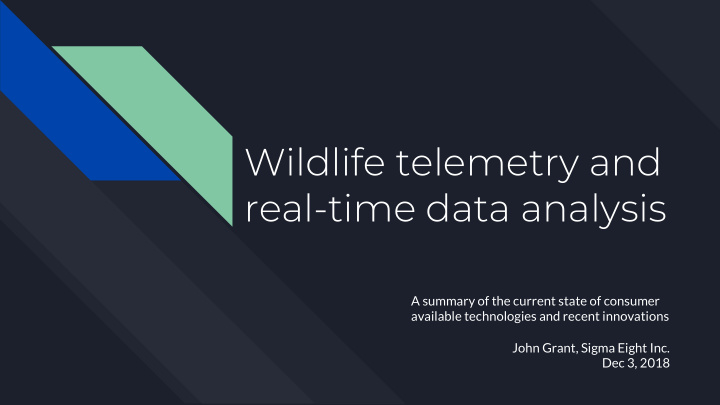



Wildlife telemetry and real-time data analysis A summary of the current state of consumer available technologies and recent innovations John Grant, Sigma Eight Inc. Dec 3, 2018
Conclude Observe Results are compared with A certain behaviour is seen How do we collect the data? the hypothesis in nature or in a subject Scientific Method Test Hypothesize The hypothesis is tested in A research asks ‘why?’, and a controlled environment proposes an explanation
Current Tracking Technologies Acoustic Acoustic GPS GPS VHF (Radio) Cost: $$ Cost: $$ Cost: $$$ Cost: $$$ Cost: $ + + Salt/fresh water Salt/fresh water + + High accuracy High accuracy + Freshwater/land + + < 1g sizes < 1g sizes location location + < 1g sizes + + 3D locations 3D locations + + Precise timestamps Precise timestamps + Low resolution locations + + No antenna No antenna - - Usually combined Usually combined + Easy-moderate to setup - - Diving often involved Diving often involved with a transmitter for with a transmitter for + Easy-moderate to - - Hard to automate Hard to automate retrieval retrieval automate - - Poor in turbulent Poor in turbulent - - High power High power - Antenna water water consumption consumption - Poor in deep or conductive - - Cannot track by Cannot track by - - Not available in < 1g Not available in < 1g water land/air land/air - No high resolution - - Aquatic animals only Aquatic animals only locations
VHF Transmitter Consists of 3 basic parts ● Emits a signal on some time ● Antenna Battery interval Emits on a specific ● frequency PCB
Data Characteristics Timestamp Receiver ID Antenna Frequency Type Code Power (dBm) e l p 2018-12-02 4 1 150.560 BEEPER 1002 -94 m a x 10:12:27 w E o R ... ... ... ... ... ... ...
Conclude Observe Results are compared with A certain behaviour is seen the hypothesis in nature or in a subject Scientific Method How do we process the data? Test Hypothesize The hypothesis is tested in A research asks ‘why?’, and a controlled environment proposes an explanation
Current Techniques ? ? - Data is often gathered manually ? - Sites visited occasionally → potential for ? long dropouts - Sites visited often → can be expensive - Data wrangle in spreadsheets, databases, or with R scripts - Scrutinize the data
Internet Solution: The internet! - Put receiver online - Respond to dropouts as required, instead of a set timeline - Centralize the database for all receivers
Automate Conclude Observe Results are compared with A certain behaviour is seen the hypothesis in nature or in a subject Scientific Method Test Hypothesize The hypothesis is tested in A research asks ‘why?’, and a controlled environment proposes an explanation
Can MITAS efficiently transmit receiver data over the internet?
MITAS Experiment Procedure: - 3 receivers were setup in our office in Aurora, Ontario, Canada Data - 2 transmitters was placed nearby, emitting every 1.1s at a moderate signal strength - A database server was setup in Sydney Australia - Experiment was run for 1 week
Results Each transmitters average contact power grouped by receiver over the 1 week experiment.
99.81 ± 0.04% Transmission efficiency
Results Explained Factors for data loss: Remedies: - Random network outages - Have wired connections when - Power outages possible - Strong bursts of noise - Ensure there is a backup source of power, and/or voltage monitors - Pick frequencies that are not busy
Demo
Next Steps Ability to add tags ● Sort data by weight, age, gender, ○ size… Emails/notifications when a tag is ○ present at receiver Migration paths ○ Daily reports ● Detection rates of beacons ○ Status reports on receivers ○ Share data ● Add other researchers to your project ○ with certain permissions Publicize data ○
All the data generated in this experiment is open source https://github.com/SEI-John/MitasEfficiencyExperiment
Questions?
Data Wrangling Grolemund, G., & Wickham, H. (n.d.). Retrieved November 27, 2018, from https://r4ds.had.co.nz/wrangle-intro.html
Recommend
More recommend